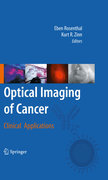
To describe principles of optical imaging including chemistry and physics of fluorescence, limitations/advantages of optical imaging compared to metabolic and anatomic imaging. Describe hardware adapted for small animal imaging and for clinical applications: endoscopes and operative microscopes. Outline FDA approved and newer optical imaging probes. Include discussion of chemistry and linkage to other proteins. Review current techniques to image cancer and the development of techniques to specifically image cancer cells. Review use of exploiting differences in tissue autofluorescence to diagnose and treat cancer. Include agents such as 5-aminoleculinic acid. Review mechanisms that require proteolytic processing within the tumor to become active fluorophores. Review useof cancer selective proteins to localize probes to cancer cells: include toxins, antibodies, and minibodies. Introduction of plasmids, viruses or other genetic material may be used to express fluorescent agents in vivo. This chapter will review multiple vectors and delivery mechanisms of optical imaging cassettes.Preclinical investigations into the use of optical contrast agents for thedetection of primary tumors in conventional and orthotopic models will be discussed. Preclinical investigations into the use of optical contrast agents forthe detection of metastatic tumors in mouse models will be discussed. Use of targeted and non-specific optical contrast agents have been used for the detection of sentinel lymph node detection. These applications and how they differ from other applications will be discussed. Because of the unique difficulty ofidentifying tumor from normal tissue in brain tissue, a separate chapter would be needed. More clinical data is available for this cancer type than any other. Discussion of potential clinical applications for optical imaging and an assessment of the potential market. INDICE: Basic principles.- Endoscopic Techniques for Optical Imaging.- TheOperating Microscope for Fluorescence Guided Surgery.- Fluorophores for Optical Imaging.- Overview of Cancer Detection and Monitoring Strategies.- The application of tissue autofluorescence in detection and management of oral cancer and premalignant lesions.- Proteinase optical imaging tools for cancer: detection and response to therapy.- Illustrating molecular events with light: a perspective on optical reporter genes.- Optical Imaging of primary tumors.- Nodal staging of cancer using diagnostic optical imaging techniques.- Optical coherence tomography for cancer detection.- Optical imaging of cancer: neuro-oncological applications.
- ISBN: 978-0-387-93873-8
- Editorial: Springer
- Encuadernacion: Cartoné
- Páginas: 230
- Fecha Publicación: 01/09/2009
- Nº Volúmenes: 1
- Idioma: Inglés
